1. Sites of Waiting
The sites of waiting implicated in detention spaces reflect a wide temporal glitch constructed from complex materialities and modes of belonging (Bosworth and Turnbull 2014, 3), representing an “emerging and continually changing assemblage of spatial tactics” (Martin and Mitchelson 2009, 467). These sites of waiting are where different action forces meet, move, burst forth and produce what distinct spaces of with their own temporal scapes, reflecting encounters with contemporary bordering practices. Indeed, as Mary Bosworth (2014, 183) acknowledges, spatio-temporal “uncertainty” marks out the experience of detention, “stretched across time and space, unfixing and denying people’s past while dictating their present and colonizing their future. It is the constant backdrop to detention and its outcome”. The partition of time is conditional to the functioning of the narrative of detention as distinctly administrative: this sense of spatio-temporal disparity reflects the fact that you ‘never quite leave’ the lawscape which attempts to regulate the national spatial imaginary through echoes of fractured and sedentary registers (Philippopoulos-Mihalopoulos 2013, 35). In this way, although legal “indeterminacy [is the] distinguishing characteristic” of immigration detention, this is inseparable from “a spatio-temporal one, as well, because detainees may be held indefinitely, in remote places…invisible and silent politically” (Martin and Mitchelson 2009, 465). Thus intedeterminacy is a deliberate effect of power: time is “stretched”, mimicking incarceration yet reflecting a liminal zone unlike in a penal space (Turnbull, 2016). However, uncertainty and indeterminacy can never be fully and properly managed through exclusion, as the lawscape always inadvertently reveals itself.
In Hotel Problemski (directed by Manu Riche, 2015), these emerging encounters with the lawscape can be read through a critical reading of the way in which the law is refracted through film. The film is about the residents of an asylum centre in Belgium who are awaiting asylum decisions, planning onward journeys and facing regular interactions with officials and institutions of the state. The critical act of reading law’s refraction through the visual allows us to take account of ruptures, material traces and spatio-temporal textures in the construction of particular spaces of non- belonging in the European imaginary. This will provide a means of interrogating the way in which law continues to shape space through a distinctive engagement with the cinematic medium as a distinctive framing technology, and thus to encounter embodiment and material presence in contemporary bordering practices. In Fig. 1, a critical analysis of composition reveals the way in which the scene of waiting is captured through film. This is a still photograph interposed within a sequence involving the residents talking with the film’s narrator, Bipul. Where before the camera tracked across multiple faces and recorded the steady hum of conversation, now the sedentary mise en scene reveals a distinct absence: the way in which the chairs are arranged in apparent disarray demonstrates the omission of bodily presence from the administrative process of granting asylum and its neglect of the corporeal. In this way, the perspective can be read as aligning towards the framed picture at the end of the room, a distant and unobtainable landscape, an unreachable utopia.
Nonetheless, the way in this chaotic simulation nonetheless seems to reflect some kind of order or sequence, as if the chairs have anthropomorphized to become benign, bright figures at a dance beneath the dome-like sun in the ceiling, gesturing towards an insistence on presence (albeit heavily mediated within a penalized system in which power imposes constraints on the ability to move freely, even in domestic scenarios). This reflects Kafka’s parable ‘Before the Law’, in which the scene of waiting is observed in the way in which the key figure is rendered passive “waiting for a justice that never arrives… subordinate to and reflective of an absolute, sovereign authority in whose name he continues to wait” (Martel 2011, 159). Following Derrida, it is possible to consider that this justice will only ever exist as a future possibility: in other words, the temporal frame of what is to-come resides in a recognition of liminality at the root of justice as “that which “does not wait” and also that which exists only as potential, as à-venir” (Martel 2011, 161).
As Ben Crewe writes, “for prisoners serving indeterminate sentences, time warps as well as drags” (Crewe 2011, 514). This is the abyss then, without movement, where waiting becomes a suspension, in Girgio Agamben’s (2005, 41) discussion of the term “iustitium [as the] ‘standstill’ or ‘suspension of the law’”, conceived of as a kind of emptying out. Yet Fig. 2 runs contrary to this reading of emptiness, by reflecting a particular way in which the space is used and produced, configured as acts of resistance (Lindberg 2017). In this sequence, a mid-angle shot taken with a zoom lens allows the audience to withdraw from the characters dancing in the frame. This creates the effect of showing the space both expand and contract: whilst the zoom allows the frame to widen to capture the framing device of the solid columns on either side of the group, the act of retreating generates a greater degree of empty space. This withdrawal is therefore simultaneously both active and passive, an indication of the concept of “withdrawal” that Andreas Philippopoulos- Mihalopoulos (2010, 211, 213) identifies when he defines an attribution of justice through spatiality as “the command to withdraw yet remain”. In this reading, law’s spatio-temporal claims retain an echo of the making of space (rather than an ‘emptying out’), highlighted in this scene through the distinctive contrast between the cold and inanimate white light of the ceiling and floor and the warmer colours of the clothes on the dancers. The effect of this withdrawal is both haunting and yet redemptive, as the haunting of the border is to be found in this negative space (Derrida 2005).

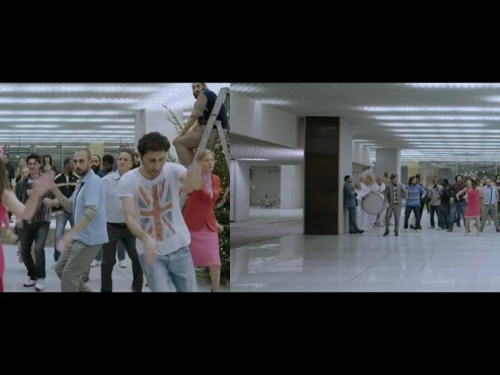
2. Concept of the threshold
The concept of ‘the threshold’ is key to this analysis as it has a distinctly double meaning: it can represent a visually present gateway beyond which space is accessed; and also a limit point in itself, in which it represents a cataclysm which provokes a reaction or defines a moment of excess. It has a particular meaning in relation to immigration detention, wherein the “suspension of time maps onto corresponding spatial ambiguity theorized often as liminality, zone of exception or threshold between states” (Mountz 2011, 381-382). The scene of waiting thus exists concurrently as a threshold to an elsewhere, and is therefore not only marked by waiting but traversed by corporeal engagement with space, “transgression and disruption and ambiguous forms of belonging that map onto partial forms of citizenship and statelessness” (Mountz 2011, 383). Hence asylum seekers are caught between the “folds” between borders, which themselves produce endless “places of limbo where people – like the sites that they inhabit – are neither precisely ‘here’ nor ‘there’” (Mountz 2011, 383). ‘Threshold’ is found in Agamben’s writing, a reflection of “a passage that cannot be completed” (Norris 2000, 39), emblematic “spatial expressions of the struggle between state and migrant” (Mountz 2011, 381). This notion is not static but evolve and must be “redrawn from epoch to epoch; so much so that every society modulates the limit of the threshold” (Downey 2009, 115). In Fig. 3, the static camera reveals a composition which can be said to signify this concept of the threshold as liminal space, capturing a state of in-betweenness through the placement of the figure in green in the centre of the frame, caught between the solid thick lines of the columns and the perspective which draws the eye to the dark negative space between them, the entrance and exit to the centre and its hidden world of non-belonging. The contrast between the living, breathing green foliage and the grey concrete between highlights this sense of suspension, and the artificial nature of this ‘out-of-placeness’ is emphasized through the uneven mirroring aspects of the mise en scene. Reading bordering, however, beyond the concept of threshold and bare life and rather (after Deleueze and Guattari) as an “event of becoming” which is generative, chaotic and transformative, demonstrates an alternative way in which to engage with the materiality exposed within the film. If bordering can be read as “a vast array of affective and transformative material processes in which social and spatial orders and disorders are constantly reworked” (Woodward and Jones 2005, 239), Fig. 4 can be read as a means of reading new affects that are produced through bordering practices that seek to then obscure or contain those very affects. The establishing shot of the skyline introduces the spatial relations we as the audience have to the setting, a bleak dream-like vision of the space surrounding the centre, glimpsed from its roof. The second exterior shot in Fig. 4 reveals the jagged edge and contours of the centre from a low angle shot at its base. These views, whilst meant to inform us of the effect of containment, introduce a surreal landscape contoured through distortion: hence, we can return to Derrida’s reading of the threshold as always reproducing itself in multiplicities: in other words, “there is no single threshold or essence of sovereignty” (Swiffen 2012, 346).
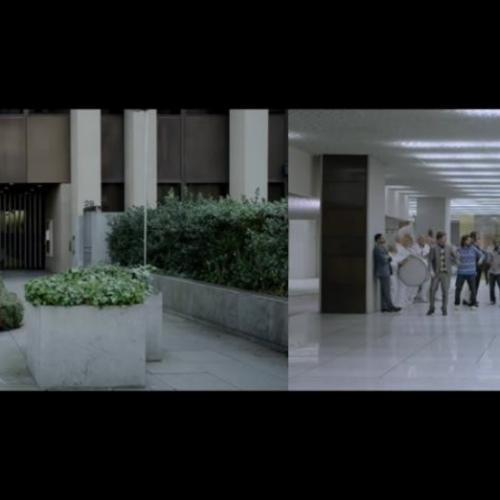
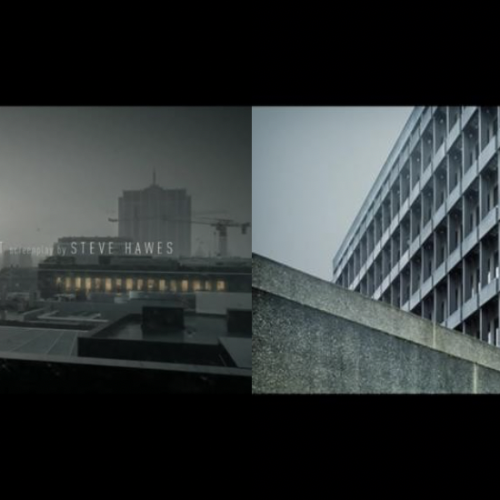
3. Encounters with embodiment
The way in which the film plays with corporeality reflects the way in which the “body of the asylum seeker becomes the (un)marked body of strange(r)ness” (Gibson 2003, 368). Yet these bodies are not simply passive, marked by their forced exclusion within the asylum process, as these “encounters are about more than the coming together of different bodies. Encounters make difference” (Wilson 2017, 455). In this way, resistance is born by the transgressive nature of encounters in the spatio-temporal lawscape, as they “demand that we rethink the limits of the body, its capacities and thresholds” (Wilson 2017, 455). The act of bordering both gestures towards containment and yet, at the same time, “sends bodies into flight” (Woodward and Jones 2005, 239). In Fig.5, the framing of the main character (and narrator of the story) Bipul at the side of the shot, almost hidden in the darkness, reflects a distinctive relationship of bodies to the other objects in the room, configured through their materiality and yet never reduced to a corporeal state of non- belonging. Bipul is marked out in the film as an unknown, without a past or a future – we are told he was found in an airport toilet and has no memory of where he has come from, “so they can’t send him back”. The use of deep focus to keep all the objects in the foreground and the midground in equally sharp focus emphasizes the material affect of disjunctive displacement, particularly when Bipul is contrasted with the figure of the speed-walking Belgian official at the centre, who moves quickly in and out of the shot, wearing a bright baby pink suit. With her status, she has the ability to transgress the boundaries of the frame, whereas Bipul must remain both absent yet present at the same time. The concept of ‘homo sacer’ would seem to be relevant here: as Bipul is positioned as Fig. 6 And yet, the act of exclusion in this film is particularly distinctive. Scenes in which Bipul seems to be positioned at the edge of the scene can be juxtaposed with shots such as Fig. 6, in which he is framed at the very centre of the composition, his silhouette only recognizable through his voice over and yet flanked distinctively between parallel columns, looking out and down towards the cityscape which is laid out before him. In this “the sacred man who can be killed by anyone (he has no rights) but not sacrificed because the act of sacrifice is only representable within the legal context of the city – the very city from which homo sacer has been banished. He is an outlawed citizen, the exception to the law, and yet he is still subject to the penalty of death and therefore still included, in the very act of exclusion, within the law.” (Downey 2009, 111) instance, the shadow lines project an image of containment which are also a recognition of the centrality of the corporeal to the project of bordering: a recognition which must be complicit in the making of the state itself, in its ongoing need to define its own edges.
Our complicity as viewers is also frequently highlighted through the use of point of view framing within the film. In Fig. 7, a jump cut introduces us to Bipul as he is accompanying a friend to his asylum tribunal interview. Once again, the use of perspective gives us a sense of a long, clinical- corridor stretching out before us as the figures of the two characters are seated on the left –rather than the centre – of the frame. When they are called in to the meeting, a dolly shot allows the viewer to follow the two men as they walk into a large, bright, white room behind the official (with once again, a notable view of the cityscape stretched out beneath its huge wide windows). The audience is therefore behind them, with them, as they go in to await the decision which will determine whether his friend can be granted access to the city before them, must continue to wait in limbo, or faces deportation. The space itself takes on the space of the city, in its clean parallel lines and observable structures of access and prohibition. In this way, the spatial order seeks to obscure the reality that “all residents of the city, even the least powerful, are involved practically (to greater or lesser degrees) in the production of space” even whilst some are “alienated from the oeuvre they are active in producing” (Garbin and Millington 2012, 2071). This denial of a “right to the city” (Lefebvre 1991) is exposed as fallible through the dynamic and fluid interdependence of the law’s relationship to the city and the figure of the itinerant outsider.

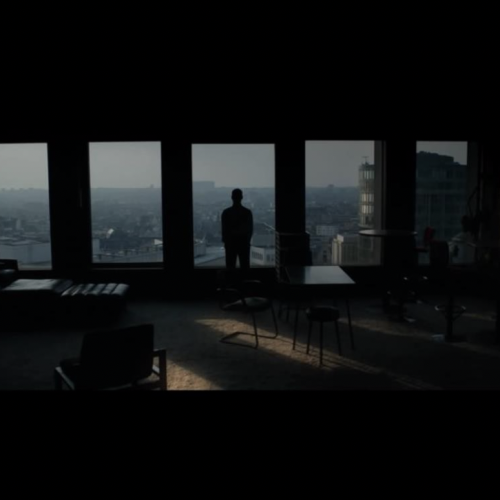
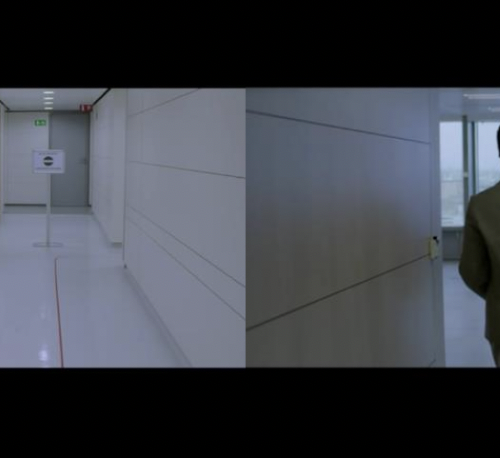
4 Metaphor of depth
As Ben Crewe writes of the penal system, it “is important to find descriptors which allow us to characterize the different components of the prison experience” (Crewe 2011, 520). It can be argued this carries even greater critical importance in the case of immigration detention in relation to its ambiguous role within the carceral state, when despite growing calls to define detention as an ‘exceptional’ mechanism it is justified as a routine administrative mechanism (Amnesty 2017), with significant consequences for those tangled in the “intolerable complexity of immigration law” (Sayed and Neale 2017, 364). Crewe argues that the previous attempt to define the prison experience through the metaphor of depth, referring to the “the degree to which the prison was oppressive and psychologically invasive” or, alternatively, as a weight which “bore upon them” through “a vertical form of oppressiveness and an almost physical sense of burden” (Crewe 2011, 521) was no longer relevant to the contemporary experience of incarceration. Crewe suggests that the metaphor of depth must be expanded to include perceptions of space and time, including ‘tightness’ as a means of capturing “the way that power is experienced as both firm and soft, oppressive yet also somehow light. It does not so much weigh down on prisoners and suppress them as wrap them up, smother them and incite them to conduct themselves in particular ways.” (Crewe 2011, 522). This expansion of depth as including tightness and weight as well as, I would suggest incorporating the particular spatiality of immigration detention (through the concept of the ‘threshold’) as a distance from, below, a bearing down upon or separation from normative space in detention provides a way in which we can map how law continues to shape space even from those individuals seemingly excluded from the nation state, by reinforcing the act of entanglement with materiality that is always operating within the scene of waiting. This is observable through the use of depth of field in the cinematic space, particularly in Fig. 8, where the sharp focus on Bipul in contrast to the darkness implicates him at the centre of the frame. The use of an arc shot – in which a moving camera circled around the subject to briefly focus on the faces of each character in the scene- introduced a sense of disorientation, before the camera finally rests on a close-up of Bipul. His head almost looks like a disembodied sculpture, yet his agency is emphasized after this scene follows sequences in which he is often positioned at the edge of the frame (see above). Bipul is not looking directly at the viewer and neither can be follow his gaze, but the use of shallow focus means we must retain our gaze upon him on a canvas of negative space. This sense of displacement enhances the uncomfortable encounter with the individual that has always previously been possible to obscure, as in Fig. 9 where the camera is static and provides a long take wide angled perspective of different rooms in the centre. Whilst the camera is still, a figure crosses in and out of the frame, providing a sense of dislocation against a composition of muted colours. The textures in Fig 9 are highlighted through an emphasis on the lines and edges of the ceiling lights and columns – a persistent theme through the film – and yet the way in which the camera leaves so much space for the floor in the shot creates a sense of cramped, rather than open, space.
For Deleuze, what made cinema so provocative was the recognition that in film “we see an act of resistance take shape, a uniquely cinematic idea which casts asunder the order which seeks to control and stratify it. [It is the] unexpected, the extraordinary, the remarkable [which have the] effect [of] loosen[ing] the grip of the system of control, even if only for a time” (Arnott 2001). The act of transgressing the frame creates an embodied resistance of presence through its gestures towards absence and withdrawal, exposing the way in which we can to some extent ‘rephysicalise’ the law through film – and thus the administrative disassociation of asylum as a process – by exposing the depth of materiality and the way in which law continues to frame and shape the spaces of belonging.
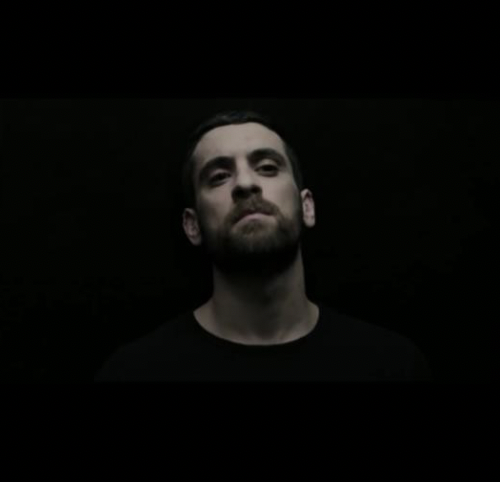

Emma Patchett is a postdoctoral researcher at the University of Helsinki. This research was supported by the Akatemian rahoittama Eurooppalaisen oikeuden, identiteetin ja historian tutkimuksen huippuyksikkö / Academy of Finland funded Centre of Excellence in Law, Identity and the European Narratives (funding decision number 312431).
References
Agamben, Giorgio. State of Exception. Trans. Kevin Attell. Chicago: University of Chicago Press, 2005.Amnesty International, ‘A Matter of Routine: The use of immigration detention in the UK’ December 2017), accessed 12 March 2018 Arnott, Stephen. “Deleuze’s Idea of Cinema”, Film Philosophy 5.32 (2001), http://www.film-philosophy.com/vol5-2001/n32arnott> (accessed 12 May 2016)
Crewe, Ben. “Depth, weight, tightness:Revisiting the pains of imprisonment”. Punishment
& Society 13.5 (2011): 509-529.
Bosworth, Mary, and Sarah Turnbull. Immigration detention, punishment, and the criminalization of migration. London: Routledge, 2014.
Bosworth, Mary. Inside Immigration Detention. Oxford: OUP, 2014.
Derrida, Jacques. “The principle of hospitality.” parallax 11.1 (2005): 6-9.
Downey, Anthony. “Zones of indistinction: Giorgio Agamben’s ‘bare life’and the politics of
aesthetics.” Third Text 23.2 (2009): 109-125.
Garbin, David and Millington, Gareth. “Territorial Stigma and the Politics of Resistance in a
Parisian Banlieue: La Corneuve and Beyond”. Urban Studies 49.10 (2012): 2067–2083.
Gibson, Sarah. “Accommodating strangers: British hospitality and the asylum hotel debate.”
Journal for Cultural Research 7.4 (2003): 367-386.
Lefebvre, Henri. The Production of Space.Trans Donald Nicholson-Smith. Blackwell: Oxford,1991.
Lindberg, A. (2017) Exploring the everyday of immigration detention. Available at: https://www.law.ox.ac.uk/research-subject-groups/centre-criminology/centreborder- criminologies/blog/2017/11/exploring (Accessed 05 Aug 2018).
Martel, James . “Waiting for Justice: Benjamin and Derrida on Sovereignty and Immanence.” Republics of Letters: A Journal for the Study of Knowledge, Politics, and the Arts 2, no. 2 (June 1, 2011): 158-172.
Martin, Lauren L., and Matthew L. Mitchelson. “Geographies of detention and imprisonment: interrogating spatial practices of confinement, discipline, law, and state power.” Geography Compass 3.1 (2009): 459-477.
Mountz, Alison. “Where asylum-seekers wait: feminist counter-topographies of sites between states.” Gender, Place & Culture 18.3 (2011): 381-399.
Norris, Andrew. “Giorgio Agamben and the politics of the living dead.” Diacritics 30.4 (2000): 38-58.
Philippopoulos-Mihalopoulos, Andreas. “Atmospheres of law: Senses, affects, lawscapes.” Emotion, Space and Society 7 (2013): 35-44.
Philippopoulos-Mihalopoulos, Andreas. “Spatial Justice: law and the geography of withdrawal”. International Journal of Law in Context 6.3 (2010): 201–216.
Sayeed, Sadat and David Neale, “Immigration and Asylum Case Law since 2016 – A Complex Picture: Part 2” Judicial Review 22.4 (2017): 349
Swiffen, Amy. “Derrida contra Agamben: Sovereignty, biopower, history.” Societies 2.4 (2012): 345-356.
Turnbull, Sarah. ’ ‘Stuck in the middle’: Waiting and uncertainty in immigration detention’,
Time & Society 25.1 (2016) : 61-79.
Wilson, Helen F. “On geography and encounter: Bodies, borders, and difference.” Progress in Human Geography 41.4 (2017): 451-471.
Woodward, Keith and Jones, John Paul. “On the Border with Deleuze and Guattari” pp 235
-248 in B/ordering Space. Eds. Henk van Houtum, Olivier Kramsch and Wolfgang
Zierhofer. Ashgate: Aldershot and Burlington, 2005.